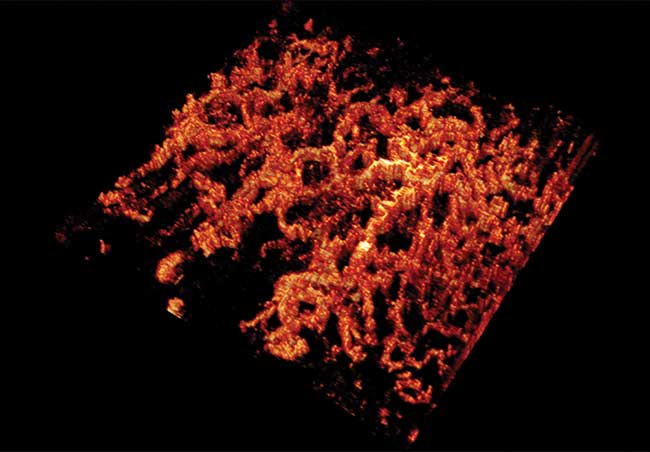Ophthalmology remains the primary application, but promising new uses in cardiology and dermatology are on the horizon.
 OCT-A — optical coherence tomography angioplasty — which allows imaging without dye, is a promising breakthrough in the detection of early-stage glaucoma. And swept-source OCT has opened new possibilities for diagnosing diabetic retinopathy and early macular degeneration.
Although ophthalmology continues to dominate the OCT landscape, this imaging technology also has seen new adaptations outside that field. In dermatology, it is used for the diagnosis and treatment of nonmelanoma skin cancer, and in cardiology it’s being used for intravascular imaging.
No wonder then that market researchers continue to predict robust growth. One such 2016 projection, by the firm Research and Markets, puts the global OCT market at approximately $1.32 billion by 2020, as the result of a projected five-year compound annual growth rate of 12 percent.
Although research has advanced in terms of speed, novel tuneable lasers and wider-band spectrometers, the cost of imaging systems is still high. The increase in the demand for OCT technology is still not matched by more affordable technology. We have witnessed continuation of spectral separation of OCT technologies, spectrometer-based for short infrared wavelengths and tuneable lasers for longer infrared wavelengths. There is an interest to expand the tuneable laser technology to shorter wavelengths, but fast-tuning-rate lasers that can cope with eye movement are not available so far. Therefore, investigating the retina is mainly performed with spectrometer-based devices, while for the investigation of skin and internal organs, tuneable laser technology is preferred. The optical source, spectrometer, digitizer and scanning devices compound into a cost exceeding five figures.
OCT-A — optical coherence tomography angioplasty — which allows imaging without dye, is a promising breakthrough in the detection of early-stage glaucoma. And swept-source OCT has opened new possibilities for diagnosing diabetic retinopathy and early macular degeneration.
Although ophthalmology continues to dominate the OCT landscape, this imaging technology also has seen new adaptations outside that field. In dermatology, it is used for the diagnosis and treatment of nonmelanoma skin cancer, and in cardiology it’s being used for intravascular imaging.
No wonder then that market researchers continue to predict robust growth. One such 2016 projection, by the firm Research and Markets, puts the global OCT market at approximately $1.32 billion by 2020, as the result of a projected five-year compound annual growth rate of 12 percent.
Although research has advanced in terms of speed, novel tuneable lasers and wider-band spectrometers, the cost of imaging systems is still high. The increase in the demand for OCT technology is still not matched by more affordable technology. We have witnessed continuation of spectral separation of OCT technologies, spectrometer-based for short infrared wavelengths and tuneable lasers for longer infrared wavelengths. There is an interest to expand the tuneable laser technology to shorter wavelengths, but fast-tuning-rate lasers that can cope with eye movement are not available so far. Therefore, investigating the retina is mainly performed with spectrometer-based devices, while for the investigation of skin and internal organs, tuneable laser technology is preferred. The optical source, spectrometer, digitizer and scanning devices compound into a cost exceeding five figures.
Member Exclusive: To read the complete article, please Login or Register